Eaten since prehistoric times, abalone is favored in Japan as a luxury foodstuff. It also has religious significance. The numbers of abalone in the Japanese seas are decreasing, however, as are the number of female free divers who have traditionally fished for abalone.
Ancient History
Abalones are shellfish belonging to the family haliotidae, the name of which is derived from the Greek words halios, meaning "sea," and otos, meaning "ear." There are about 100 known species worldwide. In Japan, where abalone is called awabi, the major species include kuro awabi, megai awabi, and madaka awabi in the south and Ezo awabi in the north.
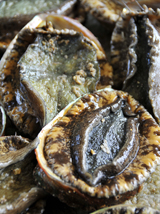
The Japanese have had a special fondness for abalone since ancient times, believing it to have been the elixir of life that Qin Shi Huang, the first emperor of the Qin Dynasty (third century BC), sought for. During the Edo period (1603-1868) dried abalone, along with dried sea cucumber and shark fin, was one of the three marine exports from Japan that were especially prized in China.
Abalone has also been known in Japan to be good for the eyes. This is evidenced by the saying in Mie Prefecture, which has a thriving abalone fishing industry, that eating abalone during pregnancy will give the child beautiful eyes. The abalone of Mie, moreover, has had an important influence on Japanese celebratory traditions. It is customary to wrap formal gifts with paper called noshi gami and to place monetary gifts in envelopes called noshi bukuro. Both of these have their origins in noshi awabi, stretched and dried strips of abalone that are still made today in Mie Prefecture.
A Female Occupation
No discussion of abalone in Japan is complete without considering the tradition of dive fishing by women. The Man'yoshu, a poetry anthology compiled around the eighth century, includes a famous poem that likens "one-sided" (unrequited) love to "the shell of the abalone that the fishers [ ama ] of Ise are said to dive for morn and eve." Since those early days, ama was a word that broadly referred to people who worked at sea. It is only relatively recently that the word was assigned the kanji characters for "ocean" and "grown man" when referring to male divers and those for "ocean" and "woman" when referring to female divers.
As Satoru Tanabe notes in his book Ama, people who dived in the Genkai Sea for fish and shellfish were mentioned as early as the third century in the Gishi Wajinden, a chapter about Japan in a Chinese history book. It is unclear whether the "water people" to whom it refers are men or women. Evidence suggests that ama existed along coastal areas from even older times; many abalone shells have been unearthed from prehistoric shell mounds across Japan.
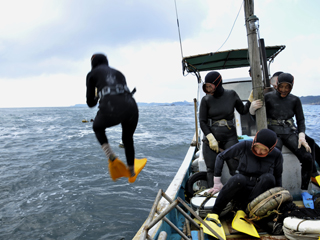
The largest number of women divers remain in the Shima and Toba districts of Mie Prefecture, which have long been famous for their ama . There are several disputed theories as to why the divers are women, including that the men were busy hunting for skipjack tuna and other fish by boat and that women are better suited to diving than men because their higher percentage of body fat keeps them warmer in the water. But according to curator Taizo Hiraga of the Toba Sea-Folk Museum, which offers detailed exhibits about the ama tradition, the key may lie in the religious significance of abalone. Ise Shrine in Mie Prefecture has valued abalone as an important offering to its deities for centuries.
"There may be a religious reason, such as that offerings to Amaterasu, the sun goddess, should be gathered by women," Hiraga speculates.
In Kuzakicho, Toba-shi, is a facility where village elders produce noshi awabi to be offered during the three annual festivals of Ise Shrine. Ise Shrine is actually a complex of 125 shrines, and abalones are presented to the deities at each of them. In all, the rituals call for about 1,000 fresh abalone and another 2,500 for making noshi awabi. The tradition of ama has endured in the Toba-Shima area precisely because of the sanctity with which it views the abalone. At the same time, the abundance of the shellfish has ensured the profitability of abalone diving and kept the occupation of ama alive.
It is also worth noting that Amakazukime Shrine in Kuzakicho has a legend that, 2,000 years ago, Yamatohime no Mikoto—a princess who is said to have founded Ise Shrine—learned of the delicious taste of abalone when an ama named O-Ben (to whom the shrine is dedicated) offered it to her.
Decreasing Abalones
In recent years, however, the all-important abalone has been dramatically decreasing. Numerous reasons have been suggested, including overfishing, sediment runoff into the ocean due to landfills and road construction, sewage contamination, displacement of seabed sand, and the effect of the Kuroshio current with its scarcity of nutrients. But researchers at the Mie Prefecture Fisheries Research Institute, which for years has been releasing juvenile abalone in the sea and making other efforts to improve the situation, suspect that changes on a larger scale, including global warming, are responsible. As for the Kuroshio current, they point out that major changes in its course are seen every 20 years.
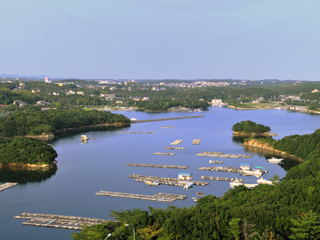
Whatever the cause, nationwide catches of abalone have plunged from 6,466 tons in 1970 to roughly 2,000 tons over the last three decades, writes Toshio Oba in his book Awabi to Nihonjin (The Culture of Abalone and the Japanese). Women divers have decreased as well. According to statistics by the Toba Sea-Folk Museum, the number of ama in Mie Prefecture was 1,081 in 2007, compared to 6,019 in 1949. Given the fact that there are very few young ama in their twenties to forties, the number is sure to drop even further in the coming years.
As Hiraga commented, "What is certain is that ama is a female profession that has continued for at least a thousand years."
It is a pity to see a millenarian tradition die away, but the life of a woman diver is not easy. They juggle diving with child rearing and housework, and those in households that engage in both farming and fishing additionally tend the fields. There are even some ama who, on top of all this, also run an inn. And abalones are not their only prey. They dive during all but the two coldest months of the year for various fruits of the sea, such as Japanese spiny lobster, sea cucumber, turban shell, sea urchin, green laver, and hijiki seaweed, as well as abalone.
Women at Sea
We were able to accompany ama to sea with the cooperation of the Kuzaki branch of JF (Japan Fisheries Cooperative) Toba Isobe. There are largely two styles of ama fishing. In the first, in which the divers are called funado ama, a husband-and-wife pair would go out to sea in a small boat, and the husband would hold onto the wife's lifeline while she dived. In the second, men known as tomae would row the boat and keep watch over the diving women, called kachido ama or okedo ama.
This day's fishing was in the latter style, with nine divers riding out on two boats. The destination was a fishing ground owned by the cooperative. The usual competition was absent, as the day had been reserved for a joint survey of the growth of juvenile abalone that the cooperative had released with the support of the Mie Prefecture Fisheries Research Institute.
As the boats neared the reef, one by one the ama jumped into the ocean with a splash. The women scattered out, each holding onto a float, and soon began quickly disappearing underwater. In a matter of minutes, several were holding up large abalones for us to see with joyful looks. All of them were in their fifties and sixties, but they kept diving with superhuman stamina during a full hour and 20 minutes, repeatedly submerging and resurfacing for 30 times or even 50.
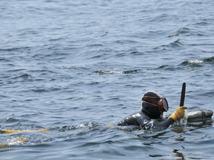
By local tradition, when a girl was born she was destined to become an ama , and there was even a saying that went, "She who cannot feed a single te [man] is not worth much as a yaya [woman]." Girls growing up in this region apparently were well aware of their future as an ama from an early age. The local communities have thus had a longstanding tradition of prizing women with superior diving abilities.
After 1 hour and 20 minutes, the ama returned with heavy catches. The women seemed exhausted as they dragged themselves back on the boats. They made a distinctive whistling sound as they steadied their breathing; it is a special breathing technique called ama bue, meaning ama's whistle, and its melancholy ring has been made the subject of poetry.
Sustainability and Seasonal Variation
Ama diving is a sustainable form of fishing. There are several reasons:
- There is a cap on the diving time allowed per day. At Kuzakicho the ama can only dive once a day for a duration of 1 hour and 20 minutes.
- Fishing for abalone is banned during their breeding season from October to December.
- In Mie Prefecture, small abalone of 10.6 centimeters or less must be returned to the sea.
- Diving gear, such as wet suits and oxygen tanks, are prohibited.
- The net bags in which the ama put the abalone that they caught, called sukari , are intentionally made with large meshes.
Another distinguishing feature of ama diving is the seasonal variation. From May to around mid-September they mainly fish for abalone, turban shell, sea urchin, and tokobushi abalone. Tengusa seaweed is taken from July to August. As these summer months also happen to be typhoon season, the divers only go out to sea for a total of 30 days at most, and as little as 10 days in some years. Japanese spiny lobster comes in season from December to April, and sea cucumber can be fished from November to December. The ama do not dive in January and February. In March they begin harvesting wakame seaweed, and May is the time for hijiki seaweed.
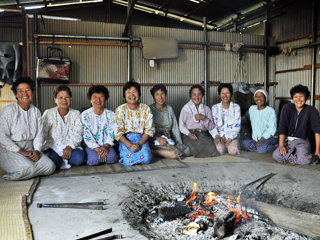
July 1 and November 15 are designated resting days, called himachi . The ama offer flowers, beans, and sake to the gods and get together for dinner. They also refrain from diving on July 13 and 14, when sharks are said to pass by for spawning. The final fishing day of the year, called nomiage , is December 26 or 27, and on this day they celebrate by cooking sekihan (red bean rice).
"It would be nice if we could go out every day," mumbles someone in the ama hut. "But there are the days, you know, when typhoons make the water cloudy for a good week or ten days. I wish our work was more steady."
To make up for the instability of ama fishing, it is common for local households to divide the time between farming and fishing. About half of the ama engage in agriculture, while also raising their children and keeping house. The daughters, having grown up watching their mothers, are rarely willing to follow in the parental footsteps. The mothers have likewise been unable to tell their daughters to take up the busy lifestyle of the ama .
Today the majority of women divers in Kuzakicho are in their fifties and sixties. But the situation here is actually better than many others; the ama in nearby Anori and Koga, where we once visited, were mostly in their sixties and seventies, and last year there was even a report of an 82-year-old ama . Nonetheless, the fact is that even Kuzakicho has not a single ama in her twenties to forties. The town has a tradition of having only one ama per household, and the number of women divers in the town has gone down from 170 in 1978 to 63 in 2009.
The primitive fishing method of ama diving is historically important, having underpinned the venerable traditions of Ise Shrine for at least 1,300 years. At the same time, it has contemporary significance as a sustainable coastal fishing technique that prevents the depletion of fisheries resources. It is to be desired that the culture of abalone fishing by women divers be kept alive by finding some way to ease the heavy workload of the ama.
Photos: Yasuko Fujisawa
